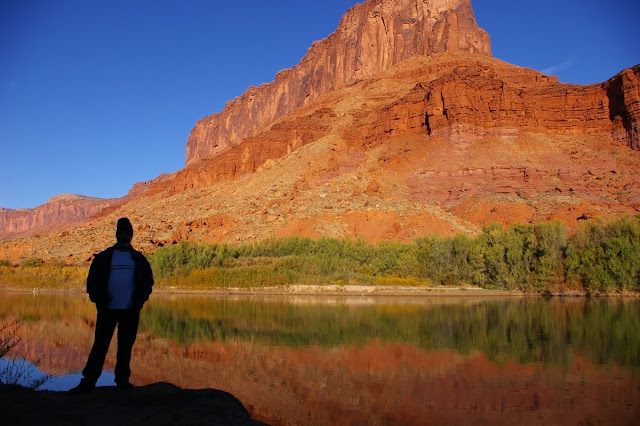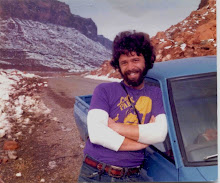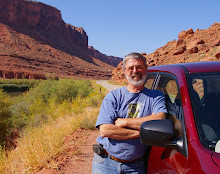Wednesday, March 27 Kanab, Utah
Today has been a long but exhilarating day,
taking in four states in 400 miles and 10 hours of driving, more or less. I left Barstow, California this morning at
6am while darkness still lingered over the Mojave. I got on that seemingly
interminable stretch of interstate heading for Las Vegas.
The oncoming dawn softened things quite a bit, imparting an eerie hazy glow
to the distant mountains and the gray stretches of creosote bush and dry
lakebeds. By 9am I was in Henderson
where I stopped at a Trader Joe’s to do some shopping. I had already made the decision to drive
straight through to Kanab, Utah rather than doing another night of camping at
Lake Mead. I just wanted to get closer
to home and the sooner the better.
As soon as I got on the road again, I headed
out of the Vegas megalopolis and into the stark hills surrounding Lake
Mead. Once again I drove the North Shore
Drive that winds through folded, upthrust mountain ranges, dark volcanic
ridges, and burnt red sandstone outcrops...all this punctuated by massive
blooms of brittle bush and desert sunflower.
I stopped at a roadside picnic area to have a short brunch of yogurt,
banana and cheese. Then back in the van
driving north through the Mormon towns of Overton and Logandale, and finally
connecting back on to the Interstate at Moapa.
I was making good time in my own leisurely way, nearly out of Nevada and
ready to cut through that small but intense slice of Arizona where the
interstate makes a spectacular climb up and through the Virgin River
Gorge. This is the gateway to the
Colorado Plateau. This is the familiar
way back.
Just past the Arizona/Utah border I got my
first glimpse of the snow-clad Pine Valley Mountains and the beginnings of the
urban sprawl that is now the greater Saint George metropolitan area. Massive stretches of desert are being scraped
away to make room for more tract homes, golf courses, RV parks. The traffic becomes intense. And I keep thinking where will all these
people get their water from. Both the
Virgin River and the Colorado are nearly tapped out, yet the building continues
unabated with unreasoning faith in the Almighty that all needs will be met. When, in fact, it is a recipe for disaster.
Nevertheless, I pushed on through as quickly
as possible with one quick stop in Hurricane for fuel. I was determined to drive through Zion
National Park even though I knew there would be hordes of tourists there and
possibly some traffic jams. Yet I
couldn’t help but feel that old magic as I made my way through Rockville and
into Springdale. I was remembering my
first view of Zion way back in 1967 on a college geology field trip. 52 years ago when this was a narrow two-lane
road and Springdale was just a tiny portal town on the edge of the park. It was spring equinox then, and
in the upper reaches of the canyon where our group all camped for the night, I
got high on weed for the first time with a biker dude named Duncan. I can still picture that shimmering moon shining
above the Great White Throne.
 I grabbed my cameras and made the easy descent
down to the edge of Clear Creek where the cold water flowed gray green through
stands of bare oak trees, yuccas and a few ponderosa pines. And no people. Above me the cars continued to wind by but, for the moment anyway, I had the creek bottom all to myself. I skirted the shoreline, photographing
patterns in the rock and listening to the sweet sound of desert water. I walked until I reached a “narrows” where
the shoreline ended and the creek was constricted between sinuous walls and the
water flowed bank to bank. By this time,
a few other humans were filtering into my space so I made my way back to the
van, feeling satisfied that I had grabbed at least a modicum of isolation and
serenity.
I grabbed my cameras and made the easy descent
down to the edge of Clear Creek where the cold water flowed gray green through
stands of bare oak trees, yuccas and a few ponderosa pines. And no people. Above me the cars continued to wind by but, for the moment anyway, I had the creek bottom all to myself. I skirted the shoreline, photographing
patterns in the rock and listening to the sweet sound of desert water. I walked until I reached a “narrows” where
the shoreline ended and the creek was constricted between sinuous walls and the
water flowed bank to bank. By this time,
a few other humans were filtering into my space so I made my way back to the
van, feeling satisfied that I had grabbed at least a modicum of isolation and
serenity.
As I continued out the east entrance road, I
was feeling grateful for all the times I have spent in this place before it became
overrun with humanity. I especially
remember the early 90s when Amy and I would come here every fall, camping in
the valley but coming up to the east rim to play and get away. Where we could capture the first light of day
with our cameras. Where we could take
off all our clothes and make love on the smooth stone. Where we could enjoy the primal experience in
the illusion of being the only people on earth for that moment. And in my old age I can still feel that rush
of passion and primitive sunlight, but we are no longer the youngsters who
could easily escape into a secret canyon.
And the secret canyons are no longer secret.
Still, it is hard to not be impressed by the
overwhelming ocean of sandstone through which the road passes. And near Checkerboard Mesa, I was duly
rewarded with sight of a small group of bighorn sheep not far off the
road. There were several females and
three newborns, perhaps only two or three weeks old. And one young ram nearby surveying his
domain. A number of tourists had pulled
over to take pictures and I did the same, but the sheep seemed nonplussed by it
all. And in so doing gave all of us the
momentary gift of excitement and awe, and a little peek into a fading mountain
west.
I have covered a lot of ground in two weeks.
Driving these long, familiar stretches my head fairly explodes with thoughts,
musings and many memories. This country
is ingrained in the fiber of my being.
Over half a century of camping, hiking, driving, exploring, working,
romancing. I feel enfolded in the rock,
imbedded in the sage, and empowered by the open space. And I can look back on incredible diversity
of experience from the seedy edges of Barstow to the old California mission at
San Miguel. Shorebirds on the mudflats
of Morro Bay and shooting stars in bloom on the hills of the Pinnacles. Bookstores in Cambria and rain clouds rising
above the Carrizo Plain.











